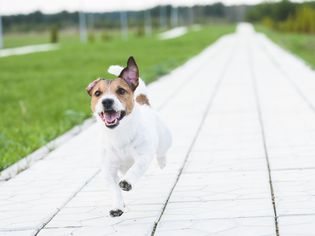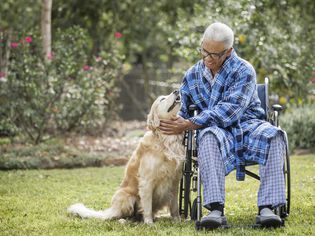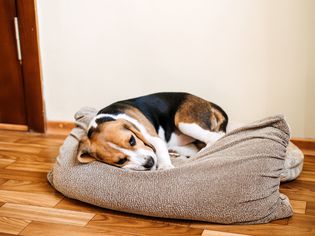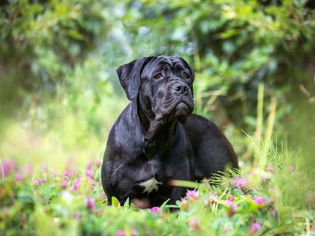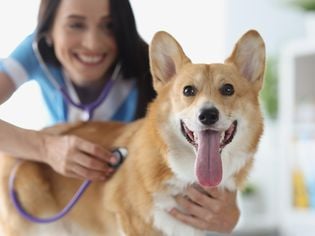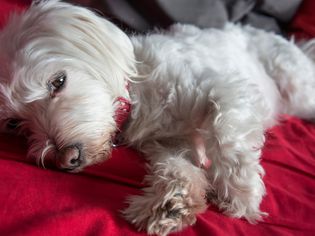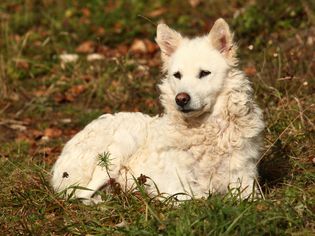The English Labrador retriever is a medium-large sporting dog breed from the United Kingdom with a short, dense, water-repellent double coat in black, yellow, or chocolate. The English Lab is technically the same breed as the American Lab, but the American version is slightly lankier. The dog features a sturdy, muscular build with a broad head, friendly eyes, and triangular ears. The Lab’s tail is medium-length and tapers toward the tip. While this breed is a strong athlete and particularly excellent swimmer, they're also a lovable companion who can excel in service and therapy work.
Learn more about the history, characteristics, and care needs of the English Labrador retriever.
Breed Overview
Group: Sporting
Height: 55 to 70 pounds (female), 65 to 80 pounds (male)
Weight: 21.5 to 23.5 inches (female), 22.5 to 24.5 inches (male)
Coat: Short double coat
Coat Color: Yellow, chocolate, black
Life Span: 10 to 12 years
Temperament: Active, friendly, affectionate
Hypoallergenic: No
Origin: United Kingdom
Characteristics of the English Labrador
English Labradors generally have a friendly and upbeat temperament. Most tend to get along well with everyone, including other dogs and strangers, when they've had proper training and socialization. High energy and an eagerness to please also help to shape the Lab's personality.
| Affection Level | High |
| Friendliness | High |
| Kid-Friendly | High |
| Pet-Friendly | High |
| Exercise Needs | High |
| Playfulness | High |
| Energy Level | High |
| Trainability | High |
| Intelligence | High |
| Tendency to Bark | Medium |
| Amount of Shedding | High |
History of the English Labrador
The ancestors of the English Labrador actually came from Newfoundland, Canada, not Labrador as their name suggests. Back in the early 1800s, there was a breed in this area known as the St. John’s water dog—also called the lesser Newfoundland—which worked on fishing boats. English nobles visiting the area took note of these dogs and ended up taking some back home with them.
The breed continued to be refined in the United Kingdom. They were used as gun dogs to retrieve waterfowl during hunts, thanks to their loyal and responsive nature and prowess in the water.
The version of the dog back in Newfoundland ended up dying out, so the Lab’s breed standard we know today came from the U.K. The Kennel Club of the United Kingdom first recognized the Lab in 1903, while the American Kennel Club admitted it in 1917.
English Labrador Care
English Labs are high-energy dogs, so plan to give them ample daily exercise. Prepare to spend some time brushing to keep up with the loose fur. Fortunately, Labs typically take well to training and socialization.
Exercise
Aim for at least a couple hours of exercise per day with your Lab. In general, Labs would rather exercise and play with you rather than be left to their own devices (which is also when they can get into trouble). Long walks, running, cycling, swimming, and hikes all are ideal activities. This retrieving breed loves vigorous games of fetch. Dog sports, such as dock diving, also are excellent ways to provide mental and physical challenges for this water-loving athlete. Training your Lab in service or therapy work can be another great option for these sociable pups.
Grooming
Although they have a short coat that doesn't require frequent grooming appointments and haircuts, they are heavy shedders. Plan to brush your Lab a couple of times per week to remove the loose fur and distribute skin oils. Expect periods of higher shedding typically as the weather changes in the spring and fall. During these times, you might have to brush daily to keep up with all the loose fur.
A Lab’s coat stays pretty clean with regular brushing, but plan to give them a bath roughly once a month, depending on how dirty your dog gets. Check your dog’s ears at least weekly to see whether they need cleaning, and be sure to dry them well after swimming and baths. In addition, trim their nails every month on average, and brush their teeth daily.
Training
Begin training and socializing your Lab when they're a puppy, if possible, to help them get comfortable with the world and prevent bad habits from forming. A puppy class is a great way to teach basic commands and manners. Labs are smart and eager to please, so they typically pick up on training quickly. Plus, they tend to be very food-motivated and respond well to positive-reinforcement training methods.
Common Health Problems
This breed is generally healthy, but it is still prone to some hereditary health issues, including:
- Elbow and hip dysplasia
- Heart problems
- Hereditary myopathy (loss of muscle strength and control)
- Eye problems
- Bloat
Diet and Nutrition
Feed your Lab high-quality food that's complete and balanced and AAFCO certified. Some Labs are prone to overeating and becoming overweight, so be sure to measure your dog’s daily diet and be mindful about treats. Discuss both the type of food and the proper amount with your vet.
Because Labs are prone to bloat, which can be triggered by eating too quickly, you might want to feed smaller, more frequent meals. Try to keep your dog calm around mealtimes, as well.
Where to Adopt or Buy an English Labrador
English Labradors are more common in the United Kingdom, but it’s still possible to find Labs of this variety elsewhere. Contact local animal shelters and Labrador rescue organizations to see whether there’s a dog in need of a home. For a puppy from a reputable breeder, expect to pay around $800 to $1,500 on average.
For more information to help you find an English Lab, check out:
- The Labrador Retriever Club Breeders Directory
- Rescue Organizations
English Labrador Pros and Cons
The English Lab can make a great addition to many families, which is why they've been one of the most popular breeds in the United States for years. However, they have a lot of energy that needs to be properly managed, and they can get into trouble if not.
Pros
- Generally takes well to training
- Often gets along well with kids and other pets
- Loyal and affectionate
- Great hunting dog
Cons
- Requires lots of exercise
- Fairly heavy shedder
- Prone to overeating and weight gain
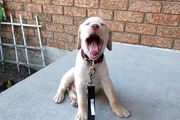
More Dog Breeds and Further Research
Before bringing home an English Labrador, do thorough research to make sure the breed is right for your lifestyle. Talk to Lab owners, rescue groups, reputable breeders, and veterinary professionals. Spend some time around the breed, too, if possible.
If you’re interested in similar breeds, check out:
- Curly-coated retriever
- Goldendoodle
- Flat-coated retriever
- What's the difference between American Labradors and English Labradors?
English and American Labradors are technically the same breed, but the English variety is slightly stockier and potentially calmer.
Are English Labradors good family dogs?English Labradors are generally very tolerant of children, as long as they’ve had proper training and socialization. Some might be a bit too energetic and enthusiastic for young kids.
Are English Labradors good apartment dogs?This breed can adapt to apartment living, as long as it gets sufficient exercise and socialization every day. Otherwise, it might become overly vocal or destructive.

